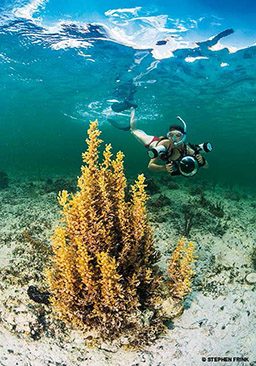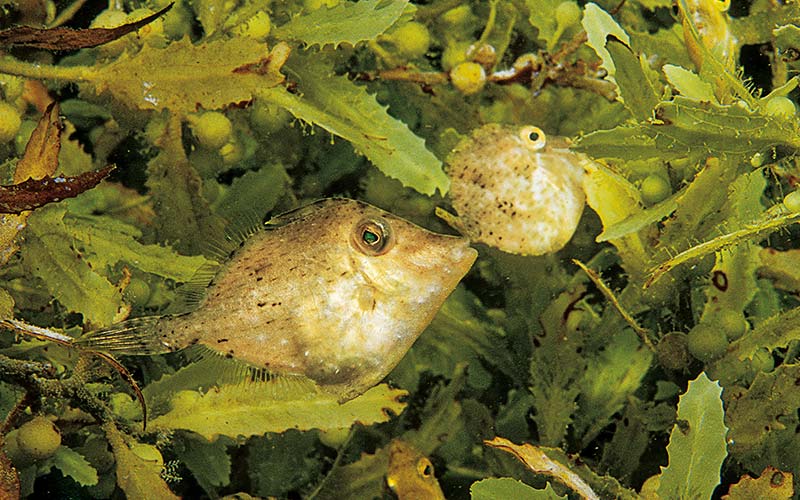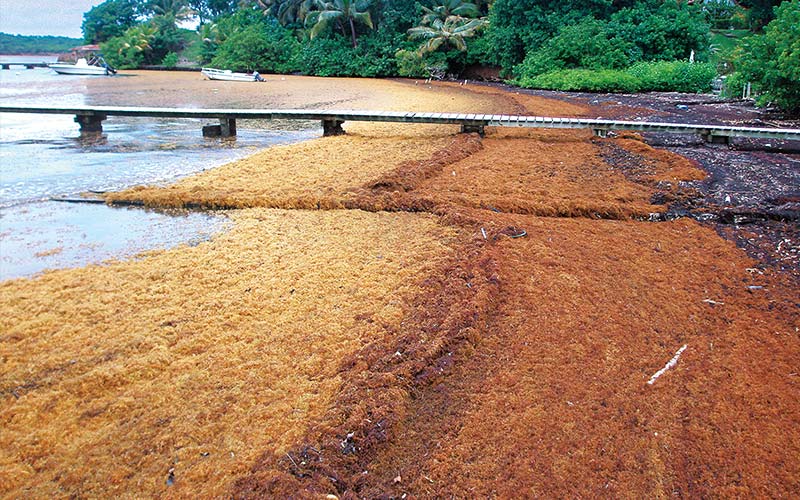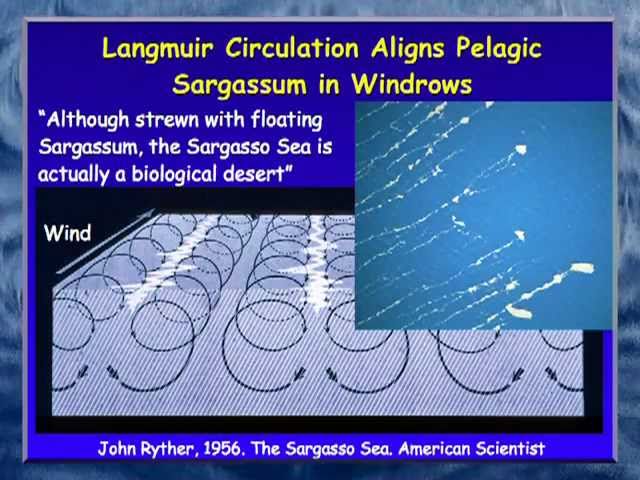Since the voyage of Columbus, the ubiquitous floating brown seaweed sargassum has been a subject of lively debate among scientists, mariners and divers. As noted in the log of the Santa Maria on Sept. 20, 1492:
The weed stretched to the north as far as the eye could see. In a way this weed comforted the men, since they have concluded that it comes from some nearby land. But at the same time, it caused some great apprehension because in some places it was so thick that it actually held back the ships.
Oceanographers now refer to the central gyre of the North Atlantic as the Sargasso Sea, a “sea without a shore,” which is defined by its boundary currents: the Gulf Stream, North Atlantic Current, Canary Current and North Equatorial Current. Because of these currents, sargassum is highly dynamic and continuously circulates between the Sargasso Sea, Caribbean Sea, Gulf of Mexico and Gulf Stream.
The floating sargassum vegetation is comprised of two distinct holopelagic (always pelagic or free-floating) species — Sargassum fluitans and Sargassum natans — that propagate by vegetative fragmentation. The plants align themselves in “weedlines” by Langmuir circulation at the ocean surface, providing a unique open-ocean habitat that supports a highly diverse and productive community. This habitat supports turtles, birds, at least 145 species of invertebrates and more than 100 species of fish, many of which are endemic. The sargassum fish and abundant shoals of jacks and filefish within and under the sargassum mats provide forage for commercially and recreationally important predators such as dolphinfish, tuna, mackerels, wahoo and billfish.

Concerns over commercial harvesting of sargassum in the 1990s led the National Oceanic and Atmospheric Administration (NOAA) to designate pelagic sargassum as “Essential Fish Habitat.” This resulted in a phaseout of commercial harvesting in U.S. waters. Efforts for additional protection grew from the 2008 Global Ocean Biodiversity Initiative, which concluded that the Sargasso Sea is a globally unique ecosystem. The Sargasso Sea Alliance has since led the conservation efforts for protection of sargassum in international waters of the Sargasso Sea.
Meanwhile, debate about exactly where the estimated 7-10 million metric tons of sargassum in the Sargasso Sea comes from — and how it grows in the oligotrophic (nutrient-poor) waters of the Sargasso Sea — continues. Oceanographer Albert Parr conducted the first quantitative studies of these plants in the mid-1930s aboard Woods Hole Oceanographic Institution’s (WHOI) first research vessel, the R/V Atlantis. Parr’s net tows indicated the biomass of sargassum was highly variable but most abundant in the Sargasso Sea, with a second area of maximum biomass in the northern Gulf of Mexico. He concluded that the two populations were likely distinct and that the sargassum in the Sargasso Sea sustained itself by “growing at a lively rate.”
Parr’s conclusions presented a paradox to oceanographers at WHOI in the 1950s whose studies in the Sargasso Sea showed extremely low concentrations of growth-limiting nutrients such as nitrogen and phosphorus. The paucity of nutrients and single-celled phytoplankton in the Sargasso Sea led John Ryther, a biological oceanographer at WHOI, to describe this oligotrophic region as “a biological desert.” Given these conditions, how could sargassum sustain itself?
Research supported by the National Science Foundation in the 1980s addressed this paradox by studying sargassum over broad areas of the western North Atlantic, including the Sargasso Sea, Caribbean Sea, southern Gulf of Mexico and the Gulf Stream. The research showed that plants in neritic (nearshore) areas of the Gulf of Mexico and Gulf Stream had much higher levels of nitrogen and phosphorus, as well as higher growth rates, compared to the oligotrophic waters of the Sargasso Sea. Abundant shoals of juvenile fishes associated with sargassum in neritic waters also play a significant role in nutrient cycling via their ammonium- and phosphorus-rich excretions. This work showed that sargassum has a dynamic and complex life cycle as it continuously circulates through the neritic waters of the North Atlantic basin, assimilating nutrients from land-based runoff.
Research on the possible effects of human activity on sargassum began in the 1970s as oil pollution from tanker discharges and oil spills increased in the North Atlantic Ocean. Although some scientists suggested that sargassum was decreasing in the Sargasso Sea based on Parr’s early work, a closer look at the data showed that the high variability in the seasonal and yearly occurrence of sargassum precluded such conclusions.

But the Deepwater Horizon oil spill on April 20, 2010, had severe impacts on sargassum in the Gulf of Mexico. Heavily oiled sargassum was burned at sea in “burn boxes,” which took a toll on the associated community, including endangered sea turtles. This spurred even greater concern by the public about the need for further protection of this community. Fortunately, Eddy Franklin, which formed in the southern Gulf of Mexico, prevented the Deepwater Horizon oil and dispersants from being carried to the Gulf Stream and, ultimately, the Sargasso Sea.
The concern that pelagic sargassum might be decreasing in abundance was totally eclipsed by a massive influx to coastal waters and beaches of Florida, Bermuda, West Africa and the entire eastern Caribbean region in the summer and fall of 2011. Even “old-timers” say they have never seen such enormous amounts of sargassum coming ashore. The mounds of sargassum on beaches posed a serious solid-waste problem for the tourism industry and was described in a New York Times article called “Where’s The Beach? Under the Seaweed.” Not only do the excessive sargassum strandings cause problems for tourism, they also impact biodiversity, biogeochemical cycling and fisheries habitat, potentially forming “dead zones” (hypoxic or anoxic conditions) in coastal ecosystems such as mangroves.

What is causing the apparent recent explosion of sargassum? The problem has been worsening along the Texas coast for decades, and it happened again in 2014 in the Florida Keys and the eastern Caribbean region. Several hypotheses have been advanced. One is that this simply represents an ever-growing eutrophication problem in the Gulf of Mexico and beyond, where increasing land-based nutrients, especially nitrogen, fuel growth. This is evidenced by satellite imagery showing high biomass of sargassum in the northern Gulf of Mexico to the west of the Mississippi River plume and also in the plume of the Amazon River in the southern Caribbean region.
A second hypothesis, not mutually exclusive with the first, is that this is related to global climate change and increasing carbon dioxide (CO2) and temperature. The increased CO2 could enhance growth of sargassum, especially if it is simultaneously enriched with nitrogen. Changes in sea surface temperature could lead to greater growth in northern latitudes and shifts in sargassum circulation patterns. Research also shows major changes in the sargassum community in recent decades, with one study revealing a large increase in amphipods (small invertebrates) compared to historic levels. A final hypothesis is that the abundance of sargassum has not changed at all and that these recent strandings of excessive biomass are just part of the extreme variability in sargassum distribution and abundance. A better understanding of the ecology and growth of sargassum awaits new research focused on testing these hypotheses.
Explore More
© Alert Diver — Q1 Winter 2015

